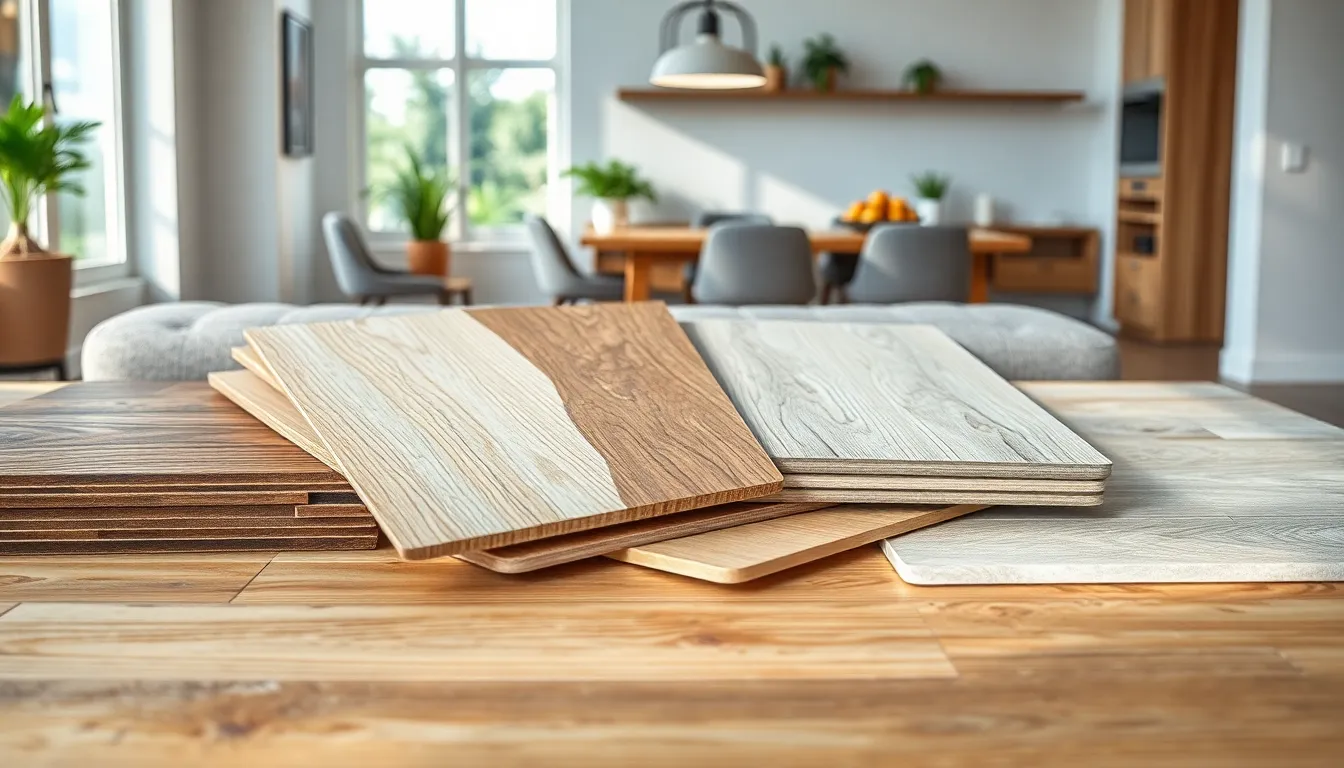Table of Contents
ToggleWhen it comes to home improvement, flooring installation can feel like a daunting task—kind of like trying to assemble IKEA furniture without the instructions. But fear not! With the right guidance and a sprinkle of humor, transforming your space can be as easy as pie (or at least easier than finding that missing Allen wrench).
Overview of Flooring Installation
Flooring installation encompasses various processes that transform a space effectively. Achieving success with installation requires the right materials, tools, and techniques. Homeowners often face choices between hardwood, laminate, tile, and carpet among other flooring options. Each type brings specific advantages, costs, and aesthetics.
Selecting materials should align with the intended usage of the space. For example, high-traffic areas benefit from durable options like tile or laminate. In contrast, comfort and warmth characterize choices like carpet for living rooms and bedrooms.
Preparation of the subfloor plays a vital role in the installation process. Ensuring a clean and level surface can prevent future complications. Measurements dictate the amount of material needed while accounting for waste is essential. Always verify the compatibility of the chosen flooring with existing elements in the home.
Techniques differ based on the flooring type. Floating installations offer convenience for some materials, while glue-down or nail-down methods are common for others. Following the manufacturer’s guidelines ensures proper installation and longevity of the flooring.
Timing matters too, as some installations require acclimatization before finalizing. Scheduling and planning allow for a smooth workflow, reducing disruptions during the installation process. When installation concludes, finishing touches like trim and baseboards often enhance the overall appearance.
With knowledge, preparation, and the right resources, homeowners can turn flooring installation into an enjoyable project, transforming their spaces efficiently and effectively. Proper guidance fosters a sense of accomplishment, making the challenge of installation manageable.
Types of Flooring Materials

Homeowners encounter various flooring materials, each offering distinct aesthetics and functionality. Understanding options helps in selecting the best fit for a space.
Hardwood Flooring
Hardwood flooring delivers timeless beauty and durability. It consists of solid wood planks that can last for decades with proper care. Many homeowners appreciate its ability to enhance property value. Available in various species like oak and maple, hardwood options cater to different design preferences. Finishing techniques, including staining and sealing, contribute to its longevity and aesthetic appeal.
Laminate Flooring
Laminate flooring consists of multiple layers fused together, mimicking the appearance of hardwood or stone. This budget-friendly alternative offers versatility and resilience. Installation is typically easier, allowing homeowners to tackle projects themselves. Available in many styles, laminate can complement various interior designs. Resistance to scratches and fading makes it ideal for high-traffic areas.
Vinyl Flooring
Vinyl flooring provides excellent water resistance, perfect for kitchens and bathrooms. This material comes in sheets, tiles, or planks, offering versatility in design. Many appreciate its comfort underfoot and ease of maintenance. With advanced printing technology, vinyl can resemble wood or stone closely. Installation remains straightforward, often achievable without professional help.
Tile Flooring
Tile flooring consists of ceramic or porcelain options, renowned for durability and design flexibility. Its resistance to water makes it ideal for moist environments. Often used in kitchens and bathrooms, tile offers extensive design possibilities, from classic to modern styles. Grouting techniques can enhance aesthetics and improve longevity. Selecting appropriate tiles can enhance energy efficiency and comfort in living spaces.
Flooring Installation Process
Understanding the flooring installation process involves careful attention to preparation, installation techniques, and the final touches. Each step influences the overall quality of the finished project.
Preparation and Planning
Preparation sets the foundation for successful flooring installation. First, assess the existing subfloor for damage and ensure it is clean and level. Then, select flooring materials according to the room’s function and aesthetic. Accurate measurements facilitate precise cutting and fitting, reducing waste and enhancing appeal. Gathering necessary tools like saws, adhesives, and safety gear ensures a smooth start. Homeowners should also consider the installation time needed based on the chosen material, as some require acclimatization before installation.
Installation Techniques
Varied installation techniques cater to different flooring types and homeowner preferences. Floating floors are easy to install, relying on interlocking planks that don’t require adhesive. Glue-down methods adhere the flooring directly to the subfloor, ideal for spaces needing a solid bond. Nail-down installation involves securing planks with nails or staples for stability, often used with hardwood. Following manufacturer guidelines is essential to guarantee optimal performance and appearance. Each technique offers unique benefits, so understanding these options aids in making the best choice for the project.
Finishing Touches
Finishing touches enhance the overall look of the installed flooring. Trim and baseboards not only cover gaps but also provide a polished finish that complements the flooring style. Transition strips serve to create smooth connections between different flooring types or levels. Caulking around edges prevents dust and moisture from settling underneath, contributing to long-lasting results. Attention to detail in these elements ultimately elevates the space’s aesthetic and ensures durability, making every step of the flooring installation worthwhile.
Common Challenges in Flooring Installation
Flooring installation often presents several challenges that can affect the overall result.
Uneven Surfaces
Uneven surfaces can complicate the installation process. Floor preparation involves leveling the subfloor to ensure stability. Using self-leveling compounds can help correct minor irregularities. Additionally, checking for dips or bumps before installation eliminates future issues. A well-prepared surface promotes better adhesion and enhances the overall finish.
Moisture Issues
Moisture issues pose significant risks during flooring installation. It’s crucial to evaluate the moisture levels of the subfloor before starting. Excess moisture leads to mold growth or warping of materials. Using moisture barriers can prevent damage, especially in basements or bathrooms. Regularly monitoring humidity levels ensures a successful installation and protects the investment.
Proper Tool Use
Proper tool use ensures a smooth and effective installation process. Utilizing the right tools for the specific flooring type minimizes complications. For instance, a flooring nailer makes installing hardwood simpler and faster. Measuring tools help maintain accuracy in cuts and spacing. Following manufacturer guidelines regarding tool use enhances results and reduces errors.
Benefits of Professional Flooring Installation
Expert flooring installation provides numerous advantages that enhance both the process and the final outcome. First, professionals possess extensive knowledge and experience, allowing for more accurate measurements and a seamless fit. Installation time often reduces with experts, minimizing disruption to the homeowner’s daily routine.
In addition, quality workmanship improves aesthetics and longevity. Professionals pay close attention to detail, ensuring each plank or tile aligns perfectly and withstands wear over time. Professional installers also possess access to high-quality tools and materials, further enhancing the overall quality of the installation.
Safety plays a crucial role in flooring installation. Professionals understand potential hazards and employ safe methods, protecting both themselves and the home. Furthermore, expert installation often comes with warranties, providing homeowners with peace of mind in case of future issues.
Cost-effectiveness also emerges as a significant advantage. While initial costs may seem higher, professional install can reduce overall expenses by preventing mistakes that lead to costly repairs or replacements.
Lastly, professionals provide valuable advice on materials and design, helping homeowners make informed decisions. Their expertise can reveal options that suit specific needs and preferences, transforming spaces into functional and appealing environments.
Choosing professional flooring installation ensures quality, efficiency, and enhanced aesthetics, making it a wise investment for any home renovation project.
Flooring installation can be a rewarding venture when approached with the right mindset and tools. By understanding the various materials and techniques available homeowners can make informed choices that suit their style and needs.
Whether opting for DIY or enlisting professional help each decision plays a crucial role in the project’s success. Attention to detail during preparation and installation ensures a beautiful and lasting finish.
Ultimately creating a space that reflects personal taste and enhances comfort is the goal. With the right guidance anyone can navigate the challenges of flooring installation and achieve stunning results.




